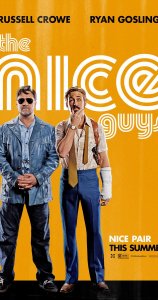* It’s charming: Charm is hard to define but easy to feel. The plot is ridiculous without being stupid, which is a more important distinction than it seems. Shane Black, the director, also did the underrated and forgotten Kiss Kiss Bang Bang. In an age of Netflix and streaming, I’m surprised Kiss Kiss Bang Bang hasn’t been rediscovered.
 * Like many caper movies (and books), The Nice Guys is about principled dirtbags, but observing life I’ve run into few, if any, principled dirtbags, and many unprincipled, standard-issue dirtbags. Shades of Elmore Leonard abound.
* Like many caper movies (and books), The Nice Guys is about principled dirtbags, but observing life I’ve run into few, if any, principled dirtbags, and many unprincipled, standard-issue dirtbags. Shades of Elmore Leonard abound.
* One of the movie’s lessons may be, “Never lose your pistol.” But it’s not really a “lesson” movie.
* The Nice Guys‘s villain is unusual and unusually interesting, though not overstated or supernatural. You may be reminded of the second, not-very-good season of True Detective. But The Nice Guys gets tone as right as True Detective gets it wrong.
* The number of people who die in cars is amazing. Even today, around 30,000 people die annually in cars. You’d think this would lead to a transportation revolution and political outcry, but it doesn’t. About 3,000 people died, once, on 9/11. If the U.S. response to mass car death were proportional to the U.S. response to 9/11, we’d be living in a very different world.
* Seattle is now larger than Detroit, and Seattle isn’t even that big (this won’t make sense unless you’ve seen the movie).
* Were the ’70s as fun at the time as they’re now depicted in retrospect?
Back in the 80s when I was in high school, the number of auto fatalities was 45,000, and it was believed that having air bags would save 9000 lives. There is a kind of inevitability to these fatalities — like it can’t be helped.
LikeLike
[note: modest spoilers follow]
Jake’s review of The Nice Guys is spot on and I also I liked it. The film is a parody of modern action thrillers/buddy cop movies, which invariably have a corporate villain at the heart of the story line. Nazis, Mafia and Russian mobsters are passé and the rest of the standard movie villain archetypes are no longer PC, which leaves corporate bad actors as pretty much the only available villain.
I won’t give away the corporate villain in The Nice Guys (Jake hints at the villain), but the reveal reveals writer and director Shane Black’s sly humor and understanding of screen writing conventions. The exceedingly convoluted plot evokes classically confusing plots like The Big Sleep (who killed the chauffeur?), honoring the Hollywood tradition of not letting the plot get in the way of a good story.
He also throws in a Hitchcock-style MacGuffin plot device to motivate our wonderfully non-self aware buddy heroes. Shane, also wrote Lethal Weapon at age 22, which has a spectacular opening scene with a gratuitous nekkid beautiful actress, and comes up with a similar eye popping opener for The Nice Guys to start the mayhem. Jake asks if LA in the late 70s was as fun as portrayed in movies like The Nice Guy and Boogie Nights. As one who lived in LA then, the short answer is yes. Shane, however, is not old enough to actually have been there then.
As my date pointed out, some of the hippy-like pontifications of one of the second leads are anachronisms from the 60s. By the late 70s, idealism had given way to hedonism. Aside from that, the dialogue, hair-dos, cars, clothes, dependence on phone booths, random shots of Tower Records on Sunset, etc., are mostly accurate.
In particular, I loved the hideous blue leather jacket Russell Crowe as Jackson Healy wears throughout the movie. In real life, Healy would have bought this at Wilson’s House of Leather and Suede in the odd pointed roof building at the confluence of Santa Monica Boulevard and Wilshire Boulevard in Beverly Hills, and the purveyor of jackets just like this one. The building is now a Starbucks, confirming that LA really was more fun 35 years ago.
LikeLike
Pingback: Once Upon A Time … in Hollywood « The Story's Story